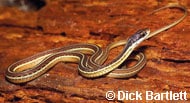Description:
A pair of Eastern Ribbon Snakes of average size may be maintained in a 20 to 30 gallon capacity terrarium. The substrate may be of fallen oak and maple leaves, folded newspaper, several thicknesses of paper towels, aspen shavings or cypress shavings. Despite the propensity of this snake for water, the substrate must be kept dry lest the ribbon snakes develop a difficult to cure blister disease syndrome. Hiding areas and visual barriers in the form of small hollow logs, securely anchored rocks or driftwood, hardy live plants, or plastic hide-boxes are accepted cage furniture. A water bowl sufficiently large for the snakes to both drink and soak should be provided. Ribbon snakes will often stool in their water. The water must be kept fresh and clean. Daytime illumination should be provided. During cold weather a small undertank heater may be used. Although these hardy snakes are not adversely affected by normal room temperatures, ribbon snakes may coil and bask beneath a heat lamp on cool days. The temperature beneath the heat lamp should be in the 90s Fahrenheit while the rest of the tank is room temperature (about 80 degrees in the summer and 74 degrees in the winter). According to the wants of their owner, ribbon snakes may be kept active through the months of winter or they may be hibernated for 90 days. Although they seldom do so, some garter snakes may choose to miss a meal during the cooler winter months. Their diet should be adjusted according to their needs. Eastern ribbon snakes eat minnows and small frogs. Ribbon snakes give birth to live young and the neonates usually eat as readily as the adults. Hibernation helps to cycle the ribbon snake for breeding. Although a clutch usually contains from 5 to 15 neonates, up to 31 babies have been documented. A heavily gravid female may refuse food for several days, or even several weeks, before the young are born. Neonates are from 7 to 9 inches in length.
Habitat:
The Eastern Ribbon snake is, in effect, a slender-bodied, very aquatic garter snake. It swims readily but remains on the waterâs surface as it forages or attempts to escape from a disturbance. Look for this pretty dark brown serpent with the precise butter-yellow stripes among vegetation along ditches, marshes, ponds, streams and other waterways. It may occasionally be seen above the water on a leaning tree or entwined in rushes and grasses.
Range:
This is the widest ranging of the 4 subspecies of eastern ribbon snakes. It occurs from central New England to southeastern Illinois and from there to eastern Louisiana and Floridaâs Panhandle and southeastern South Carolina.
Scientific Name: Thamnophis sauritus sauritus
Species Group: garter-snake
Family: Natricidae (still considered to be in the family Colubridae, subfamily Natricinae by some researchers).
Size: The eastern ribbon snake commonly attains an adult length of 16 to 24 inches. It tops out at about 38 inches. Occasional examples reach 48 inches.
Level: beginner
Weight:
Dangerous: No



